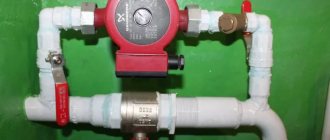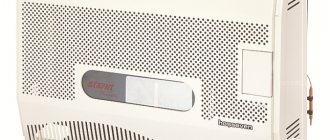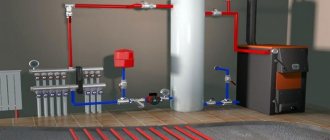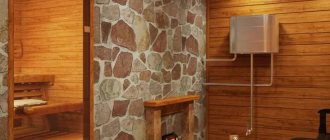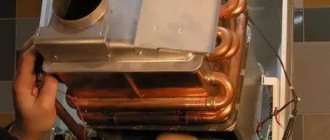Here you will learn:
- What is a biofireplace
- What is biofuel
- Advantages of biofuel fireplaces
- Construction and design of a biofireplace
- Types of fireplaces and their costs
- Choosing a biofireplace
- Installation of a biofireplace
- Types of biofuels and their features
- Biofuel consumption and operating efficiency
- How to make biofuel yourself
- Rules for the safe operation of a biofireplace
Biofuel fireplaces are a modern, environmentally friendly, safe and stylish design element or structure for heating a room. These fireplaces run on biofuel. They can be installed on the floor, on a table, on a wall, or built into a classic fireplace.
What is a biofireplace
Why do owners increasingly choose biofireplaces? It's simple. A fireplace with biofuel operates on a biostandard - it is an environmentally friendly fuel. For such a device, you will not need to prepare firewood, look for a place to store it, and there will be no soot, soot, or debris near the heating device.
The composition of biofuel for fireplaces is simple; it contains purified alcohol, which is obtained after processing plants. When such fuel burns, there are no emissions of soot and various toxic elements.
As a result of combustion, everything breaks down into carbon dioxide and water vapor. A little carbon dioxide is released. Thanks to this content, there is no need to install ventilation in the house.
Just a note! If you need to install a fireplace in a small room, then it is better to choose a device that runs on biofuel. There will be no contamination and the design itself is much simpler.
DIY making
If you wish, you can make biofuel for the fireplace with your own hands. Ethanol, the main component of fuel, can be freely purchased at the pharmacy. The alcohol concentration in purchased raw materials will vary between 90-96%. Cooking fuel at home is a simple process that will not cause problems. To obtain coloring, you can use regular refined gasoline, which is used in lighters. To check its quality, just look and smell the substance. It should be transparent and odorless.
To prepare biofuel, you need to mix 1 liter of ethanol and 100 g of gasoline. You need to use such a product as quickly as possible, since after a while it will begin to delaminate.
According to statistics, a properly prepared product has extremely low consumption and very high efficiency. A home fireplace will consume no more than 400 g of fuel per hour of operation.
What is biofuel
For the operation of eco-fireplaces, special combustible compositions are used, obtained from the processing of biological waste or made from plant materials. It gives a beautiful “live” flame without sparking, odors, soot and smoke.
The most common type of fuel is denatured ethanol. Additionally, it is enriched with special additives that color the fire a warm orange color.
And for those who want to enjoy the complete illusion of a fire with the characteristic crackling of firewood, there are special biogels that contain sea salt.
Ecofuel is sold in the form of a liquid or jelly-like gel in cans, bottles or canisters with a capacity of 1 to 5 liters, and the compositions can be flavored or neutral
The composition of industrial ecofuels should contain at least 95% bioethanol, 3-4% water and 1-2% various additives (for example, methyl ethiketone or bitrex), which prevent the mixture from separating into water and alcohol and give a beautiful color to the flame.
To choose the right fuel for your fireplace, focus on the heating performance of the fuel (on average, about 6.5 kW/h of heat is generated when burning 1 liter) and the availability of a quality certificate.
Although regular alcohol can be used as fuel for a fireplace, its bluish flame cannot be compared with the warm fire characteristic of burning wood that bioethanol produces
But if you wish, you can make the dressing mixture yourself.
For this you will need:
- Purified 96 percent ethyl alcohol with a colorless flame - 1 liter.
- Gasoline with a high octane number, for example, “Galosha” (simple automobile gasoline will not work - a characteristic odor will be released when burning) - 50 ml.
- Aromatic additives from essential oils (optional) – 5-7 drops.
Then you need to mix the liquids in the specified proportions, shake until smooth and pour into the burner or fuel block.
The disadvantage of this method is that the flammable composition is suitable for use only immediately after preparation; it will not be possible to make a reserve for long-term storage - the mixture will separate.
What to look for when choosing?
Although buyers are most often guided by the appearance of the device and its compliance with the interior design, they should not lose sight of the technical characteristics of the device.
The longer the fireplace burner, the more area it can heat, and if you plan to use the device as an additional heat source, consider options with a power of 3 kW or more
Important parameters:
- The power of the biofireplace varies from 1 to 7 kW. The higher this indicator, the greater the heat transfer from the device, as well as the brighter the flame and the higher the column of fire. But the consumption of expensive fuel increases proportionally.
- Fuel tank volume – from 50 ml to 9 liters. Of course, a device with a large capacity functions longer without refilling, but since it is not recommended to leave unused liquid in the device, it is worth estimating the actual operating time of the fireplace before purchasing.
- Burner material - for safe operation of the device, this element must be made of high-quality stainless steel 3-5 mm thick or ceramics.
- Double circuit burner – provides additional thermal insulation and controls the fuel level. For example, if you pour a lot of fuel, its excess will “go” into the second circuit and will be consumed only after the liquid is burned in the first.
But fuel consumption, which is often of interest to buyers, is a very relative value, because much depends on the power of the device, the size of its tank and the specified flame power. In an hour, an average-sized fireplace can consume from 350 ml to 1 liter of combustible mixture, so many manufacturers indicate either a consumption “fork” or the required minimum for starting.
Advantages of biofuel fireplaces
Let's talk about the main advantages of biofuel fireplaces and how the modern system works.
- Let's start with the fact that a biofireplace is a version of a home fireplace with a live fire that “plays” in a glass space, which ensures safety for surrounding people (especially children and animals) and furniture.
- Installing a bio-fireplace is a mere trifle compared to its “wood-burning” version. An eco-fireplace does not require a smoke exhaust system.
- The fuel for the fireplace is biologically pure liquid fuel - this is alcohol, which burns without residue and does not in any way harm the health of others. The combustion temperature of the fuel is low, and the evaporation of carbon dioxide is so small that a regular candle can be considered a more dangerous source of heat.
- Fuel for the fireplace is freely available, and there is no need to allocate a separate room for its storage (for example, as with firewood).
- A wide variety of eco-fireplace models allows you to create the kind of interior you have long dreamed of. Individual fireplace models are selected in accordance with the design of the room where the fireplace will be located.
- The use of a biofireplace does not imply the presence of soot and dirt.
- Such fireplaces are affordable.
- A biofireplace without a chimney is an excellent source of heat.
- And most importantly, perhaps, their advantage is that a biofireplace can be easily installed in your own, even not too large, apartment.
What are the advantages of a biofireplace
1. Environmental friendliness. It is not by chance that we put this advantage in first place. Considering how the environmental situation is developing today (deforestation, reduction of natural resources, air pollution), liquid fuel fireplaces are a very promising analogue of wood-burning hearths.
2. Versatility. You can install an eco-fireplace in almost any room. In this case, it is important to take into account its area and intelligently correlate it with the line of fire.
There are no strict restrictions for installing a biofireplace.
Even for a room less than 10 square meters. m will have its own tabletop mini-hearth.
3. Simple and quick installation. Many models are delivered assembled and ready to go straight away. Built-in fireplaces are more labor-intensive, but they can also be installed on your own.
4. Security. The design of the bio-fireplace is thought out in such a way as to completely prevent fire from escaping beyond its boundaries (if the instructions are followed). In other words, to start a fire, you have to try!
The bio-fireplace can even be combined with wood trim and wallpaper.
Its flame temperature reaches 450 °C, which is 2 times less than that of a wood-burning fireplace.
5. Easy operation. The eco-fireplace does not require any maintenance, and it works properly for decades. The rules of use are extremely simple. Caring for the device is simple: you just need to wipe off dust from the case, remove fingerprints and stains from the protective glass.
Construction and design of a biofireplace
The design of an eco-fireplace consists of a fuel module and a decorative body (metal, stone, glass-ceramic or any heat-resistant material).
The device body can be either open or closed. The flames are insulated with fireproof glass in the form of a protective screen.
The firebox looks like a burner or is a fuel block - a more complicated device. For a fuel module, the most important indicator is its power, by which the power of the device itself is judged.
The operation of an eco-fireplace begins with filling the heating tank with fuel and lighting the wick. The flame is even and bright, and there is no smoke from the chimney. The intensity of combustion is regulated by a special grille (slider).
A distinctive feature of a biofuel fireplace without a chimney is that it will take only about twenty minutes to heat a room measuring one hundred square meters.
Device
The most important part of a biofireplace is the burner. The base and firebox, unlike real appliances, are only decorative elements. Often the burner can be purchased separately. It is installed in the combustion hole in the fireplace or false fireplace. This design allows you to easily transform an ordinary device into a biofireplace.
There are two main zones in the biofireplace. These include:
- Furnace part.
- Decorative elements.
Decoration
The devices are decorated in different ways. Style is possible from classic to hi-tech.
Traditional models are decorated with strict portals, or a frame can be made of wood, metal, or stone. The burner is often hidden in a chamber behind glass facades.
There are many designer exclusive bio-fireplaces. Original unusual shapes of different sizes, any colors, made from various materials. Often styles and functions are mixed and very interesting products are obtained.
You can design a bio-fireplace with your own hands. There is also the opportunity to make biofuel yourself.
Need to know! You can make biofuel yourself, but it is better to buy it ready-made. At home, it is not always possible to accurately calculate the proportions of alcohol and other components.
Tiled stoves
If everything is clear with fireplaces, then it is very difficult to imagine a stove that heats the whole house and is not connected to the chimney. Indeed, no matter how cheap biofuel is, it is unlikely to be economical to use it to heat large areas.
The principle of operation of tiled stoves
The task of a stove, unlike a fireplace, is to accumulate heat and gradually release it into the environment. Conventional solid fuel brick kilns use a complex system of smoke channels. Passing through them, hot smoke heats the brick walls, from which so-called radiant heat flows into the room.
But installing chimneys is not always possible, and sometimes it is dangerous or unprofitable, for example, if we are talking about light country houses that are not used in winter. For many gardeners who spend a lot of time on their plot, a stove for a summer house without a chimney is a dream. And it can be realized if you install a tiled stove.
Tile is one of the best heat accumulators, so its use in the construction of stoves increases their efficiency. This material is able to withstand very high temperatures, accumulate enormous amounts of heat and create the most favorable air exchange proportions for humans.
For reference. In this case, we are not talking about tiles for cladding walls and floors, but about high-quality ceramic material, suitable not only for finishing, but also for constructing self-supporting structures.
All of the above does not explain in any way how such a stove can operate without a chimney. In fact, everything is very simple: if instead of a firebox for burning wood or coal, you equip a tiled stove with a water or electric heater that works on the “warm floor” principle, it will not need any chimney.
Chimneyless tiled stove
The tile can be heated in any way, you will still get pleasant radiant heat at the output, and the surface of the stove will never heat up to a critical temperature that can cause a burn. Only a tiled stove can, once heated up well, retain heat for several days.
Types of fireplaces and their costs
The first type of fireplace is a floor-standing fireplace. It has gained great demand and popularity among the advanced urban population. In its production, manufacturers actively use high-quality glass, metal and durable marble. If we talk specifically about a wall-mounted fireplace, then it is considered the most effective and favorable, according to experienced specialists in this field of activity. The corner fireplace is particularly compact and versatile.
The outdoor fireplace has the most elongated body. A mini-fireplace serves as an additional and beautiful decorative element of a living space. The cost of floor-standing fireplaces varies up to two hundred thousand Russian rubles. The price of wall-mounted fireplaces starts from two hundred thousand Russian rubles. Corner fireplaces cost on average eighty thousand Russian rubles. The most inexpensive outdoor fireplaces and mini-fireplaces, their maximum price is sixty thousand Russian rubles. Also on sale now you can see numerous harmless biosuppositories, the price of which is approximately six thousand Russian rubles.
Choosing a biofireplace
The choice of a biofireplace begins with the choice of model, that is, with the design. There are built-in, floor-standing, suspended, wall-mounted and tabletop models. There is even a completely unique bio-fireplace called Flut, which is designed for use in swimming pools. It is simply immersed in water and either floats freely or is fixed in one position using a special stretching mechanism.
For the manufacture of bio-fireplaces, the following are used: alloyed corten steel (ultra-strong and corrosion-resistant steel), oxidized and stainless steel, varnished fiberglass, varnished MDF, heat-resistant glass, granite, tempered glass, genuine leather.
Each biofireplace model has one or more liquid biofuel burners built into it. The capacity of the burners can be from 2 to 10 liters. The materials from which the biofireplace is made and the characteristics of the burners included in it are indicated in the description of each model.
The variety of models, ease of installation and operation of biofireplaces, safety and exclusive design make biofireplaces very popular in the design of apartments, hotels, clubs, restaurants, offices, covered verandas and private pools.
Installation of a biofireplace
Biofireplaces are the easiest appliances to install, as they do not require a chimney. Island models can be placed anywhere: on a table, chest of drawers, floor, veranda or in the garden. Wall-mounted biofireplaces require simple non-professional assembly, which will require fifteen minutes of free time and a regular screwdriver. The devices are mounted on a flat section of the wall.
If you decide to install a built-in bio-fireplace, you will need to carefully follow the installation instructions of the fireplace manufacturer and consider the fire resistance rating of the niche in which you will place it. Installation may vary from model to model, but any fireplace that runs on bioethanol will be ready for use immediately after installation.
Design Features
Construction of a biofireplace The
“Eco” model consists of two parts: a body (portal) and a fuel block. The housing can have different designs and shapes. Glass, stone, wood, steel, etc. are used to make it. Inside it there is a fuel block into which biofuel is poured. The fuel block may have a different volume, depending on the selected fireplace model. The internal design of the fuel blocks is also different. It can consist of two parts, separated by a partition, or have a complex structure in the form of a honeycomb.
Types of biofuels and their features
The prefix “bio” in the name of the fuel determines its environmental friendliness. After all, renewable natural resources are used in the production of this type of fuel. The main components used in the production of environmental fuel are grains and grasses with a high content of sugar and starch. Thus, cane and corn are the most suitable raw materials for creating biofuel.
Biofuel for biofireplaces, produced from natural components, is not inferior in its energy characteristics to the following less environmentally friendly analogues:
- biogas, which is a product of specific processing of various waste waste, like natural gas, is used to create thermal and mechanical energy;
- bioethanol, almost entirely consisting of alcohol, can replace gasoline;
- Biodiesel is made from vegetable oil for fueling cars and other purposes.
For lighting bio-fireplaces, preference is given to bioethanol, a colorless and odorless liquid. Among its advantages the following are noted:
- Environmental friendliness is due to the complete absence of carbon monoxide, soot and soot production.
- Easy to clean burners.
- High fire safety and reliable use of fuel due to thermal insulation of the fireplace body.
- No need to install ventilation devices.
- Convenience of transporting the fuel itself and ease of installation of the device.
- Possibility of adjusting combustion intensity.
- High heat dissipation.
- There is no need to prepare firewood or clean up dirt, debris and ash near the fireplace.
- The vapors released when ethyl alcohol is heated help normalize the humidity level in the room.
Ecological fuel
The name “biofuel” clearly reflects the concept of this product, created exclusively from biological raw materials. Biological raw materials mean fuel created in the process of processing waste products of vital activity of organisms, which can be of animal or plant origin. It is the prefix “bio” that confirms that plant raw materials were used in the fuel production process, which means the product is completely environmentally friendly.
It is believed that biofuel for a fireplace is one of the best types of fuel, which potentially does not even require a chimney. It is this fuel that is used to fire eco-fireplaces.
It is noteworthy that biofuel for fireplaces is denatured ethanol, created from simple ethanol in production. Ethanol is nothing more than alcohol obtained from sugar-rich plant materials, such as sugar cane, wheat, beets, and potatoes. Some types of fuel are created from alcohol obtained from cellulose raw materials and wood. Alcohol is obtained through the hydrolysis of cellulose.
Since pure alcohol is not allowed for sale, biofuel for biofireplaces and conventional models is created on the basis of denatured ethanol. Thus, we can conclude that the composition of biofuel is based on ordinary alcohol.
Biofuel consumption and operating efficiency
The average consumption of biofuel based on bioethanol is from 0.36 to 0.5 liters per hour. During the combustion of 1 liter of fuel, about 5 kWh of thermal energy is released. In terms of its performance, a biofireplace is similar to a standard electric heater with a power of 3 kW.
The main difference between the operation of these two heating devices is the ability to humidify the air when using a biofireplace, while a conventional electric heating device dries out the air very much.
The efficiency of a biofuel fireplace is about 95%. This fuel is very economical in consumption.
In order for a pleasant smell to appear in the room while the bio-fireplace is operating, it is enough to drop a few drops of any essential oil on the decorative elements. In order for the flame in the fireplace to have warm colors, it is necessary to purchase fuel with special additives.
Combustion quality and carbon monoxide level control
When bioethanol burns, water vapor and carbon dioxide CO2 are formed. Carbon dioxide itself is not dangerous, since this gas is released by humans when breathing. Carbon monoxide (CO), a colorless and odorless gas, is dangerous to human health. Carbon monoxide may be released when using biofireplaces in the following cases:
- if the burner design does not provide good combustion quality;
- if the air in the room is not sufficiently saturated with oxygen necessary for any combustion process.
In these cases, incomplete combustion of the fuel occurs, leading to the release of carbon monoxide rather than carbon dioxide. It is very important to comply with the manufacturer's recommended correspondence between the burner dimensions and the area of the room .
How to make biofuel yourself
To make good and safe fuel for a biofireplace, you need to prepare some ingredients:
- standard, which is sold in a pharmacy;
- highly purified gasoline.
The standard must be strong - 96%, and only purified gasoline is suitable, for example, it can be gasoline for lighters. With the right ingredients, you can prepare fuel quickly and effortlessly.
- For a liter of alcohol you will need 50-80 grams of purified gasoline. The components must be mixed until smooth (at first they may separate). It is recommended to mix the components before use, then the gasoline will not have time to separate from the alcohol.
- Do-it-yourself fuel needs to be poured into an iron container or into a fireplace burner, after which you can light it and enjoy a uniform flame without any smell, soot or burning. During operation of the biofireplace, it is recommended that the window be open to allow carbon dioxide to escape.
Do-it-yourself biofuel is no worse than store-bought. If a fuel-burning fireplace burns for an hour, 0.4 liters of fuel will be consumed. With a 2.5 liter fuel tank, the fireplace can burn for about 8 hours without refueling.
Disadvantages of eco fireplaces
The main disadvantage is the high cost
- High price. You have to pay more for cleanliness and environmental friendliness, which is why “Eco” models are much more expensive than conventional fireplaces.
- Unnaturalness. Due to the fact that artificial fuel is used to light the fireplace, it is not entirely natural.
Some consumers claim that throwing wood and enjoying the smell of a real fire is much more pleasant than admiring an artificially created flame.
